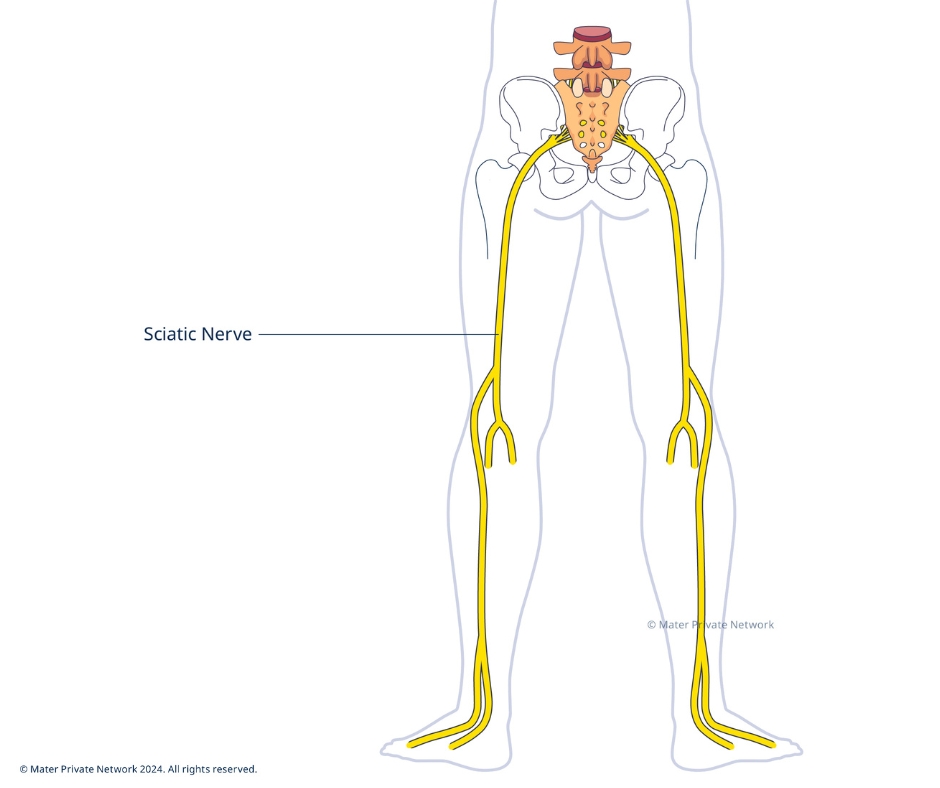Sciatica
What is sciatica?
Sciatica, which is also called lumbar radiculpathy, is the irritation or compression of one or more nerve roots in the lumbar spine (sciatic nerve). Your sciatic nerve is the main nerve in your leg, and is the longest and thickest nerve in your body. It’s up to two centimetres wide, and despite its name, is actually a bundle of nerves that come from five nerve roots which branch off from your spinal cord.
You have two sciatic nerves, one on each side of your body. Each one travels through your hip and buttock, down the leg and reaches just below your knee. They then split into other nerves that connect to parts farther down, including your lower leg, foot and toes. Because of this, injury can cause pain in all of these areas.

What are the symptoms of sciatica?
Symptoms include pain, numbness, weakness and tingling, and may vary depending on the severity of the injury and its location.
What causes sciatica?
Sciatica can be caused by a variety of spinal conditions, one of which is a herniated disc, where the interior of the disc bulges out and compresses the nerves. Another common cause is degenerative disc disease where weak discs allow the spinal bones to move off position, potentially pinching nerve roots. A third cause is spinal stenosis – when bones, discs and joints degenerate, causing bony spurs to develop and push into the spinal canal, again putting pressure against the nerve roots.
How is it diagnosed?
Your doctor will discuss your medical history and symptoms with you and carry out a thorough physical examination. You may also need to have further tests and investigations including:
- X-ray to examine the bones and rule out certain causes.
- MRI (Magnetic Resonance Imaging) to look at the bones and soft tissues in detail.
How is sciatica treated?
Treating sciatica usually involves trying to decrease pain and increase mobility. Many treatments are things you can do yourself. Milder cases of sciatica usually improve with self-treatment. However if you have pain that is moderate to severe, with numbness and tingling or muscle weakness, you need to seek professional medical care.
Self-treatments can include:
- Ice to reduce pain and swelling during the first few days after sciatica pain starts.
- Heat after the first days of using ice, switch to a heat pad.
- Over-the-counter medicines such as nonsteroidal anti-inflammatory drugs (NSAIDs) to reduce pain, swelling and inflammation.
- Stretching and strengthening activity.
Conservative treatments
Conservative treatments can involve the following:
- Prescription medications to alleviate symptoms.
- Physiotherapy to reduce pressure on the nerve.
- Spinal injections which can provide up to three months relief.
- Alternative therapies such as yoga.
Surgery interventions
Surgery may be the best option when sciatica is more severe. Usually, healthcare providers don’t recommend surgery unless you have symptoms that indicate nerve damage is happening or imminent. They may also recommend surgery if you have severe pain that prevents you from working or going about your usual routine, or if your symptoms don’t improve after six to eight weeks of conservative treatment.
Surgery options to relieve sciatica include:
- Discectomy: this is a surgery that removes fragments or small sections of a herniated disk that are pressing on a nerve.
- Laminectomy: each vertebra has a rear section called the lamina (it’s on the side of the vertebra just underneath the skin of your back). A laminectomy involves removing a section of the lamina that’s pressing on spinal nerves.










